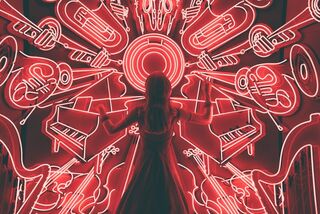Creativity
The Two Sides of Musical Creativity
Being willingly dualistic can help musicians be at their most creative.
Posted January 5, 2022 Reviewed by Jessica Schrader
Key points
- Performers who don’t consider themselves particularly creative in their music-making can take steps to boost their creativity level.
- Psychological research reveals that creativity has a dualistic nature.
- Musicians may want to work with multiple ideas and revise them toward the best ultimate outcome.

All musicians—no matter their preferred styles or areas of specialization—are creative artists. Composers are considered by many to be musicians par excellence, presumably because of their passion and productivity in generating new musical material. Performers who regularly improvise are similarly given special creative status for producing original music, and doing so expertly and in the moment. All musicians, though, are creative. This is true even of those who exclusively perform the compositions of others from notated scores and only after much practice and preparation. Even these much-rehearsed performances result in musical moments that had not existed before.
Performers who don’t consider themselves particularly creative in their music-making should consider making a concerted effort to boost their creativity level. The benefits can be quite rewarding once they embrace greater creativity as an opportunity. Are there really musicians who don’t consider themselves creative, or who shy away from creativity? In fact, many musicians—perhaps especially those with advanced training in the Classical tradition—have adopted performance practices that can limit creativity. The well-accepted Werktreue concept prescribes that performers have a responsibility to be faithful to the true meaning of musical work, understood to be the composer’s creative intent. Also the lack of improvisation of today’s Western art music is quite conspicuous, especially compared to other current genres and even to earlier eras in “classical” music (Hill, 2017).
With an emphasis placed on performance “accuracy” and faithfulness to a composer’s intent, musicians can see their craft not as a creative enterprise, but more of a re-productive one. They may not aspire to do things differently than they’ve been done, but to do them as well as they’ve ever been done. In other words, they are going for excellence over innovation. This is an important distinction, one that Harvard psychologist Howard Gardner made in his work on creativity. Gardner emphasized the distinction between experts who pursue greatness in a domain and those seeking to challenge and change the domain in which they perform. Gardner’s work also indicated that highly creative people first attain a level of mastery of their domain before going on to become creative in it.
So what do accomplished musicians need to do in order to become more creative? Intuition may suggest that it is merely a matter of adopting a mindset of non-conformity. Creativity is often treated as a single personality trait: a person who is eccentric, “off-beat,” or just does things differently than most people might be described as having a creative mind. Psychological research, however, reveals that creativity is not unidimensional; rather, it has a dualistic nature.
Perhaps the most well-accepted version of the dualism is in the two types of thinking required in creativity. Divergent thinking involves the ability to generate multiple ideas within certain parameters. This is what we commonly call “brainstorming.” Convergent thinking, on the other hand, involves considering multiple ideas, revising and reworking them toward the best ultimate outcome. This could be considered the process of refining, editing, or “workshopping” ideas. Acknowledgment of both processes is seen in the so-called “geneplore” (generate + explore) concept advanced by a number of creativity researchers (Finke et al., 1992; Kozbelt et al., 2010).
A slightly different perspective on this dualism is this: For an idea—or work of art—to be truly creative, it must be both original and useful (Cropley & Cropley, 2010). In other words, it’s only half the task to simply come up with something that nobody else has thought of before. For that something to be creative, in addition to it being new (or novel or unconventional), it must also effectively serve the purpose (i.e., be functional or useful) for which it was created. Eminent creativity researcher Dean Keith Simonton included this duality in what he called the “most favored definition” of creativity:
It must produce an idea that is both (a) original, novel, or surprising and (b) adaptive or functional. So Einstein’s general theory of relativity is highly creative because it was highly original (i.e., constituting a substantial break with Newtonian physics) as well as highly functional (e.g., it solved a problem in Mercury’s orbit that hitherto lacked any workable solution). (Simonton, 2010)
What does this mean for musicians? Most generally, it emphasizes the need to be multidimensional in the ways they think about music. To be truly creative, it is not enough for performers to aspire to make interpretations “fresh,” “bold,” or otherwise out of the ordinary. They must also strive to make their interpretations of works effective. This may mean monitoring the effect that performances have on audience members or perhaps soliciting the feedback of other musicians. Composers and songwriters should not be satisfied thinking up a compositional technique or chord progression that has never been used before; they must also concern themselves with whether these novel ideas work in the actual musical context in which they’re used.
It probably is not unusual for individual musicians to favor one of the two sides of creativity in their work. This may be why some people favor working in a two-person team, so one can focus on being the “idea person” and the other the “follow-through person.” More specific to music, some music researchers have categorized some composers as “working types” and others as “inspirational types” (Bogunović, 2019; Holtz, 2009). The creative process of working-type composers is described as methodical and labor-intensive, whereas inspirational type composers seem to be less conscious of their process and often experience it as ideas simply coming to them from mystical sources. Psychologically speaking, it is likely that both types of composers engage in both generative and explorative sides, but individuals characterize the process by either the divergent new idea-generating stage (inspirational types) or the convergent explorative refining stage (working types). Pulitzer Prize and Grammy Award-winning composer Jennifer Higdon described the necessary combination of approaches when she shared how she respond to composition students asking her if they should wait until they are inspired. “No,” she explained, “you should be sitting there writing every day to get the inspiration in the first place” (Raines, 2015).
Although artists need to carry out both sides of creativity, they are usually well served to not try to do both at the same time. The phenomenon known as “writer’s block” can result when people generate original ideas and immediately reflect critically on them. They essentially engage in divergent and convergent thinking simultaneously. A mindset of critical reflection is helpful in the stage of explorative refining, but it can be a major impediment to new idea generation, which is better served by a mindset of lowered inhibitions and nonjudgment.
Musicians who consider themselves performers, but not creators, may be able to give their musicianship an extra spark by finding ways to boost creativity in their musicianship. One way is to allow planned performances to be more improvisatory. Instead of practicing a single way to make the music expressive in an upcoming performance, musicians can prepare multiple ideas and decide which to carry out in the moments of performance. There are other ways that improvisation can be incorporated into “classical” music performance, including by preparing options for “improvised” cadenzas, among others.
References
Finke, R. A., Ward, T. B., & Smith, S. M. (1992). Creative cognition: Theory, research, and applications. Cambridge, MA: MIT Press.
Hill, J. (2017). Incorporating improvisation into classical music performance. In J. Rink, H. Gaunt, & A. Williamon (Eds.), Musicians in the making: Pathways to creative performance (pp. 222-240). Oxford, UK: Oxford University Press.
Holtz, P. (2009). What's your music? Subjective theories of music-creating artists. Musicae Scientiae, 13(2), 207-230. https://doi.org/10.1177/102986490901300202
Kozbelt, A., Beghetto, R. A., & Runco, M. A. (2010). Theories of creativity. In J. C. Kaufman & R. J. Sternberg (Eds.), The Cambridge handbook of creativity (pp. 20-47). Cambridge, UK: Cambridge University Press.
Raines, R. (2015). Composition in the digital world: Conversations with 21st-century American composers. New York: Oxford University Press.




